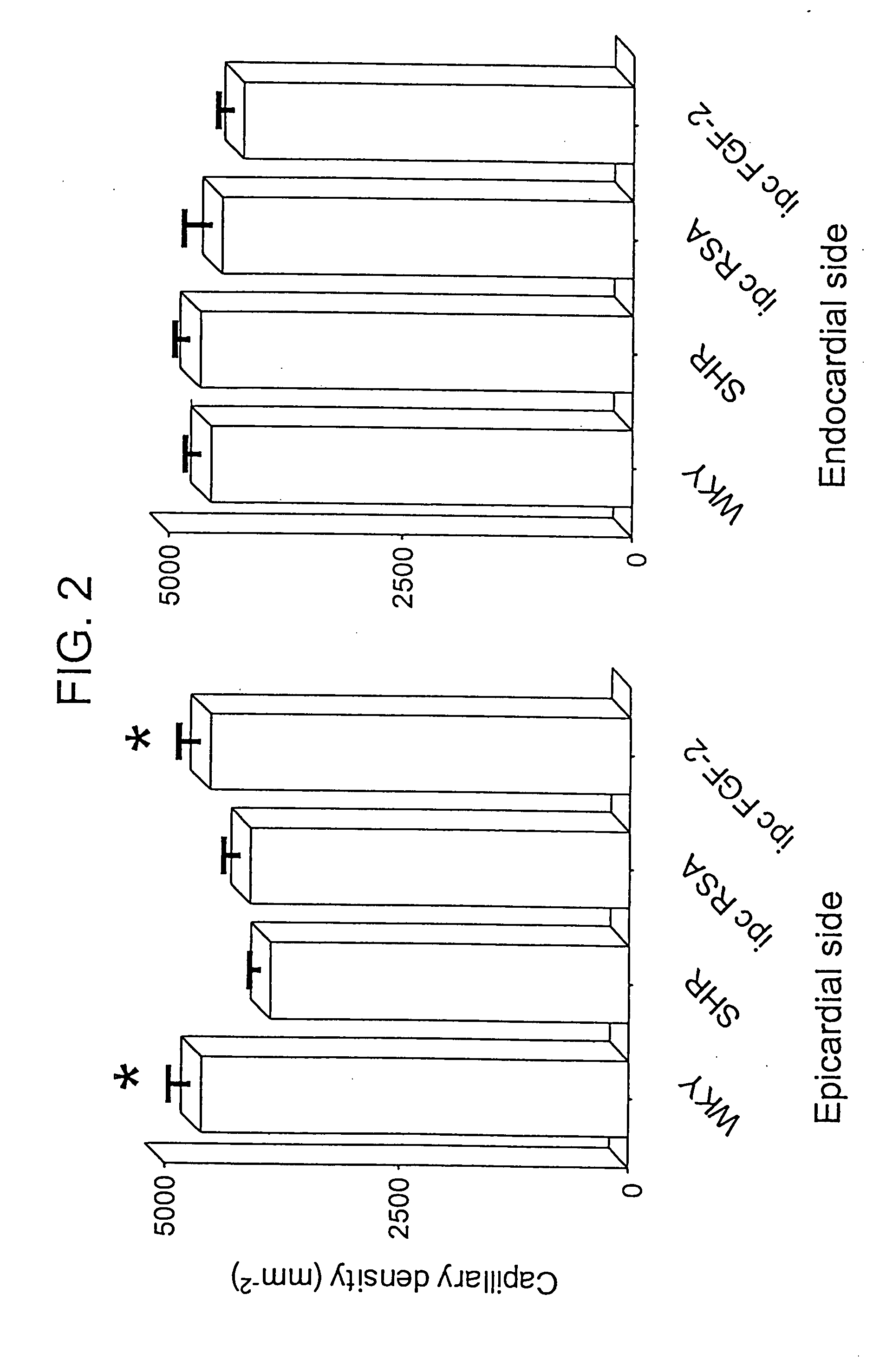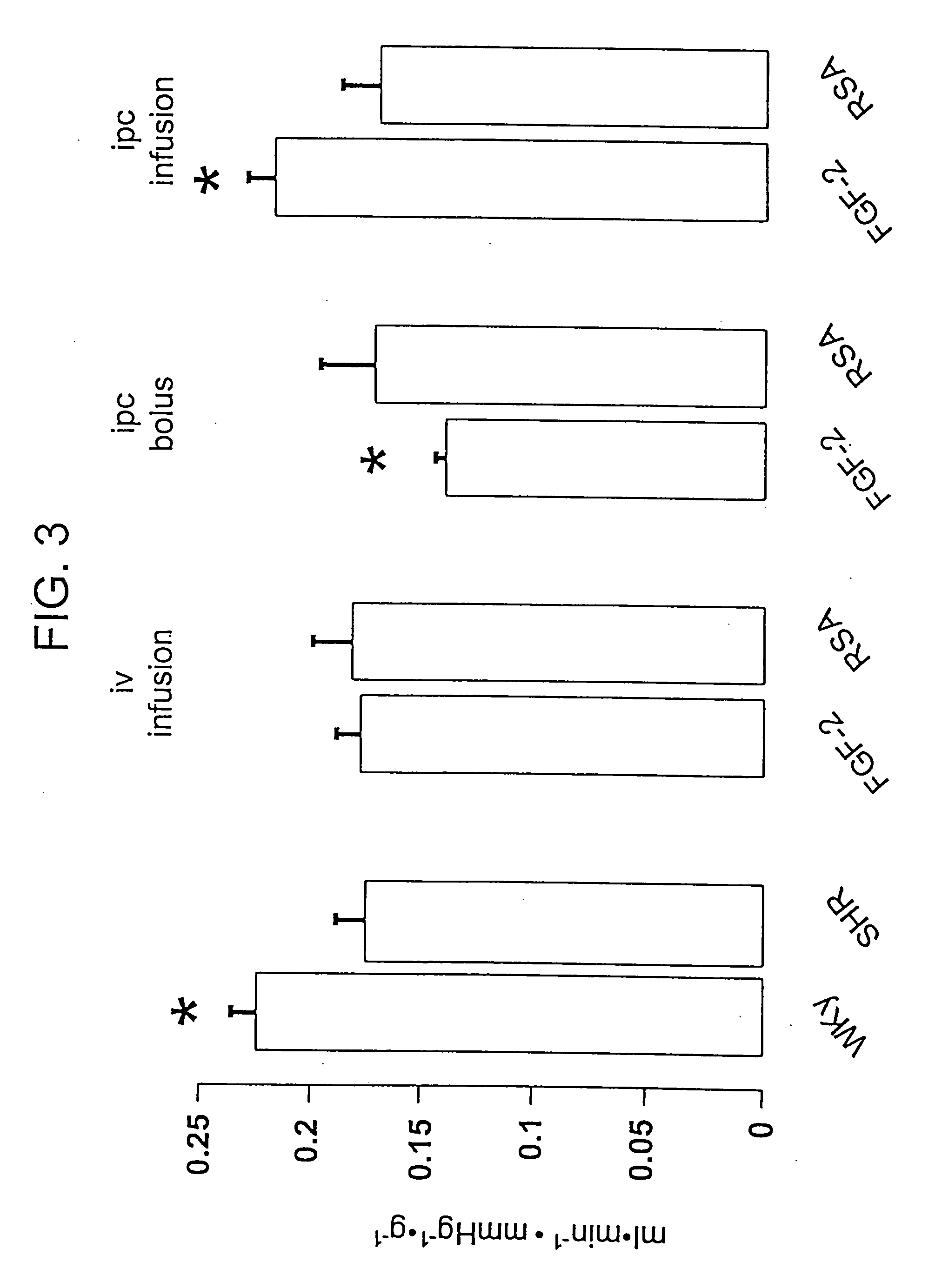Delivery of drugs from sustained release devices implanted in myocardial tissue or in the pericardial space
- Summary
- Abstract
- Description
- Claims
- Application Information
AI Technical Summary
Benefits of technology
Problems solved by technology
Method used
Image
Examples
example 1
FGF Delivered to Myocardial Tissue from an Osmotic Pump with a Catheter
[0219] A DUROS™ or ALZET™ osmotic pump is used to deliver a formulation containing FGF to the heart. A catheter is used to deliver the drug formulation from the pump to the target site. The pump is implanted at a site outside the myocardium, preferably subcutaneously, in the chest area, under the arm. The catheter is threaded through the chest wall to the heart where the distal end is implanted into the myocardial tissue and fixed in place using sutures.
[0220] The formulation consists of 1% FGF and 0.033% heparin in PBS (USP) buffer. The formulation is prepared by dissolving Fibroblast Growth Factor (Sigma Chemical Co.) and heparin (Sigma Chemical Company) in PBS (USP) to form a solution containing 1% FGF and 0.033% of heparin. An osmotic pump is then filled with the formulation with a syringe under aseptic conditions. A DUROS™ pump may be used, having a drug capacity of 150 microliters. The release rate of for...
example 1a
FGF Delivered to the Pericardial Space from an Osmotic Pump with a Catheter
[0221] An osmotic pump may be used to deliver a formulation containing FGF to the pericardial space of the heart. The pump is implanted at a site outside the heart, preferably subcutaneously, in the chest area, under the arm. The catheter is threaded through the chest wall to the heart where the distal end is implanted through an incision in the pericardial membrane into the pericardium or myocardial tissue and fixed in place using sutures.
[0222] The formulation consists of 1% FGF and 0.033% heparin in PBS (USP) buffer. The formulation is prepared by dissolving Fibroblast Growth Factor (Sigma Chemical Co.) and heparin (Sigma Chemical Company) in PBS (USP) to form a solution containing 1% FGF and 0.033% of heparin. An osmotic pump is then filled with the formulation with a syringe under aseptic conditions. A DUROS™ pump may be used, having a drug capacity of 150 microliters. The release rate of formulation f...
example 2
FGF Delivered from a SAIB Depot to Myocardial Tissue or to the Pericardium or Sprayed Directly onto the Heart Surface
[0223] In this embodiment FGF is delivered from a depot comprising sucrose acetate isobutyrate (SAIB). A formulation is prepared by mixing SAIB (Eastman Chemical Co.) and benzyl benzoate (Aldrich Chemical Co.) and ploy (DL-lactide-co-glycolide) (DL-PLG) or DL-poly(lactide) (DLPL) in a ratio of 83:12:5 (weight basis) and stirring until a homogeneous mixture is achieved. 10 μg of human, recombinant Fibroblast Growth Factor (FGF) (Sigma Chemical Co.) is added to 500 μL of the SAIB:benzyl benzoate:DLPLG formulation.
[0224] The final depot formulation is prepared by passing the mixture repeatedly between a pair of 5 ml syringes equipped with needles. Multiple passes are performed until a homogeneous suspension is achieved. The final concentration of FGF in the depot is 0.002 μg / μL.
[0225] To determine, in vitro, the release of FGF from the formulation, 500 μL of the depot...
PUM
| Property | Measurement | Unit |
|---|---|---|
| Temperature | aaaaa | aaaaa |
| Time | aaaaa | aaaaa |
| Viscosity | aaaaa | aaaaa |
Abstract
Description
Claims
Application Information
 Login to View More
Login to View More - R&D
- Intellectual Property
- Life Sciences
- Materials
- Tech Scout
- Unparalleled Data Quality
- Higher Quality Content
- 60% Fewer Hallucinations
Browse by: Latest US Patents, China's latest patents, Technical Efficacy Thesaurus, Application Domain, Technology Topic, Popular Technical Reports.
© 2025 PatSnap. All rights reserved.Legal|Privacy policy|Modern Slavery Act Transparency Statement|Sitemap|About US| Contact US: help@patsnap.com



